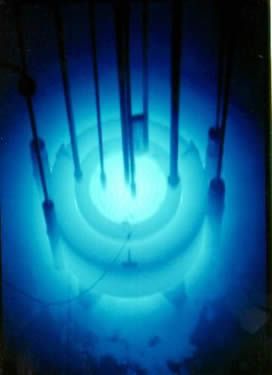A page from the "Causes of Color" exhibit...
Color effects near the speed of light

You’ve probably never seen the inside of a nuclear reactor, but the shock wave of blue light (called Cerenkov radiation) is analogous to a more familiar phenomenon – the sonic boom.
What is Cerenkov radiation?
Cerenkov radiation is a bluish light or flash frequently seen in nuclear reactors where water is used as a moderator. Pavel Cerenkov discovered Cerenkov radiation in 1934, while he was studying the effects of radioactive substances on liquids. He noticed that water surrounding certain radioactive substances emitted a faint blue glow.
Why does it happen?
Cerenkov radiation occurs when charged particles like electrons are moving faster than the speed of light in a particular medium. A shock wave is generated in much the same way as the more familiar sonic boom created by supersonic airplanes. When an airplane travels through the air, the wings push the air in front of them out of the way. If the airplane is travelling faster than the speed of sound, the air cannot move out of the way fast enough. This creates a sudden, intense pressure drop that moves away from the wing at the speed of sound, just like the wake behind a boat. We experience this pressure front as a loud noise (known as a sonic boom) heard after the airplane has passed overhead.
The electrically charged particles that make up high-energy radiation are surrounded by an electric field. As these charged particles move through a medium, the electric field moves with them. The electric field is propagated by photons, so it can only move at the speed of light within that medium. When a charged particle travels at speeds less than the speed of light for the medium, these photons tend to cancel each other out and no light is seen. However, if a charged particle travels faster than the speed of light in that medium, it “gets ahead” of its electric field. Photons are emitted with a slight lag, allowing them to escape without interfering with each other. The shock wave is in the form of light rather than sound, seen as a flash of blue light for a single particle, and as a faint glow for a continuous flow of particles.
While no particle can exceed the speed of light in a vacuum (3.0 x 108 m/sec), it is possible for a particle to travel faster than light in certain media, such as water. The speed of light in a particular medium is related to the speed of light in a vacuum and the refractive index of the medium. Most Cerenkov radiation is in the ultraviolet spectrum, but part of the energy is visible light and is seen as a blue glow.
Why is the light blue in water?
Water is intrinsically blue because of its selective absorption of the red end of the spectrum. One explanation of the Cerenkov effect in water is that the atoms in the water become excited by the Cerenkov shock wave and then de-excite, emitting blue light.
Another possible explanation is that the number of photons emitted by such a charged particle is inversely proportional to wavelength. This would mean that more photons are emitted with shorter wavelengths, thereby moving the spectrum to the blue side.
How can we apply the Cerenkov effect?
Cerenkov radiation can be used to facilitate the detection of low concentrations of biomolecules. Enzymatic and synthetic methods are used to introduce radioactive atoms. The Cerenkov effect allows researchers to detect these at low concentrations. This method is used to study biological pathways and to characterize the interaction of biological molecules (such as affinity constants and dissociation rates).
In nuclear reactors, Cerenkov radiation is used to detect high-energy charged particles, and is also used to characterize the remaining radioactivity of spent fuel rods.
Astronomers use Cerenkov radiation to study the properties of high-energy objects in space that emit gamma rays, such as supernova remnants and blazars. The effect is also used to determine the source and intensity of cosmic rays. In experimental particle physics, Cerenkov radiation is used for particle identification.




